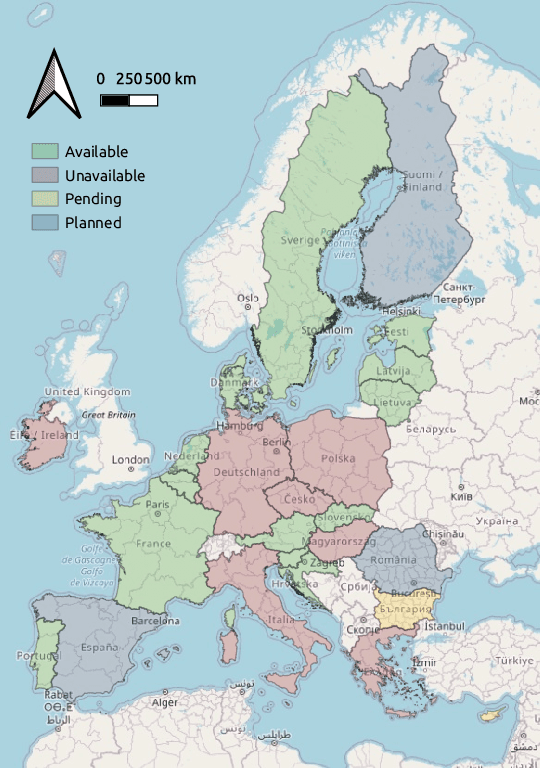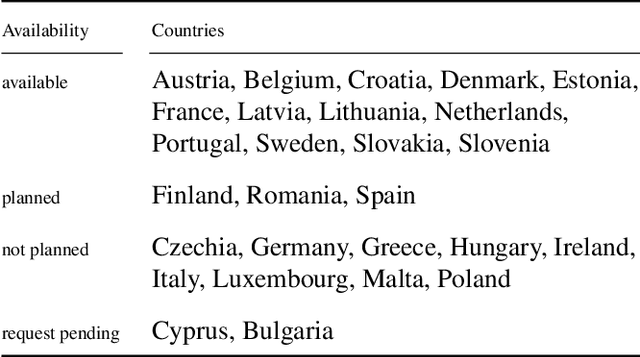Maja Schneider
Harnessing Administrative Data Inventories to Create a Reliable Transnational Reference Database for Crop Type Monitoring
Oct 10, 2023Abstract:With leaps in machine learning techniques and their applicationon Earth observation challenges has unlocked unprecedented performance across the domain. While the further development of these methods was previously limited by the availability and volume of sensor data and computing resources, the lack of adequate reference data is now constituting new bottlenecks. Since creating such ground-truth information is an expensive and error-prone task, new ways must be devised to source reliable, high-quality reference data on large scales. As an example, we showcase E URO C ROPS, a reference dataset for crop type classification that aggregates and harmonizes administrative data surveyed in different countries with the goal of transnational interoperability.
XAI for Early Crop Classification
Oct 10, 2023


Abstract:We propose an approach for early crop classification through identifying important timesteps with eXplainable AI (XAI) methods. Our approach consists of training a baseline crop classification model to carry out layer-wise relevance propagation (LRP) so that the salient time step can be identified. We chose a selected number of such important time indices to create the bounding region of the shortest possible classification timeframe. We identified the period 21st April 2019 to 9th August 2019 as having the best trade-off in terms of accuracy and earliness. This timeframe only suffers a 0.75% loss in accuracy as compared to using the full timeseries. We observed that the LRP-derived important timesteps also highlight small details in input values that differentiates between different classes and
Boosting Crop Classification by Hierarchically Fusing Satellite, Rotational, and Contextual Data
May 25, 2023Abstract:Accurate in-season crop type classification is crucial for the crop production estimation and monitoring of agricultural parcels. However, the complexity of the plant growth patterns and their spatio-temporal variability present significant challenges. While current deep learning-based methods show promise in crop type classification from single- and multi-modal time series, most existing methods rely on a single modality, such as satellite optical remote sensing data or crop rotation patterns. We propose a novel approach to fuse multimodal information into a model for improved accuracy and robustness across multiple years and countries. The approach relies on three modalities used: remote sensing time series from Sentinel-2 and Landsat 8 observations, parcel crop rotation and local crop distribution. To evaluate our approach, we release a new annotated dataset of 7.4 million agricultural parcels in France and Netherlands. We associate each parcel with time-series of surface reflectance (Red and NIR) and biophysical variables (LAI, FAPAR). Additionally, we propose a new approach to automatically aggregate crop types into a hierarchical class structure for meaningful model evaluation and a novel data-augmentation technique for early-season classification. Performance of the multimodal approach was assessed at different aggregation level in the semantic domain spanning from 151 to 8 crop types or groups. It resulted in accuracy ranging from 91\% to 95\% for NL dataset and from 85\% to 89\% for FR dataset. Pre-training on a dataset improves domain adaptation between countries, allowing for cross-domain zero-shot learning, and robustness of the performances in a few-shot setting from France to Netherlands. Our proposed approach outperforms comparable methods by enabling learning methods to use the often overlooked spatio-temporal context of parcels, resulting in increased preci...
Privacy in Practice: Private COVID-19 Detection in X-Ray Images
Nov 21, 2022



Abstract:Machine learning (ML) can help fight the COVID-19 pandemic by enabling rapid screening of large volumes of chest X-ray images. To perform such data analysis while maintaining patient privacy, we create ML models that satisfy Differential Privacy (DP). Previous works exploring private COVID-19 ML models are in part based on small or skewed datasets, are lacking in their privacy guarantees, and do not investigate practical privacy. In this work, we therefore suggest several improvements to address these open gaps. We account for inherent class imbalances in the data and evaluate the utility-privacy trade-off more extensively and over stricter privacy budgets than in previous work. Our evaluation is supported by empirically estimating practical privacy leakage through actual attacks. Based on theory, the introduced DP should help limit and mitigate information leakage threats posed by black-box Membership Inference Attacks (MIAs). Our practical privacy analysis is the first to test this hypothesis on the COVID-19 detection task. In addition, we also re-examine the evaluation on the MNIST database. Our results indicate that based on the task-dependent threat from MIAs, DP does not always improve practical privacy, which we show on the COVID-19 task. The results further suggest that with increasing DP guarantees, empirical privacy leakage reaches an early plateau and DP therefore appears to have a limited impact on MIA defense. Our findings identify possibilities for better utility-privacy trade-offs, and we thus believe that empirical attack-specific privacy estimation can play a vital role in tuning for practical privacy.
EuroCrops: A Pan-European Dataset for Time Series Crop Type Classification
Jun 14, 2021



Abstract:We present EuroCrops, a dataset based on self-declared field annotations for training and evaluating methods for crop type classification and mapping, together with its process of acquisition and harmonisation. By this, we aim to enrich the research efforts and discussion for data-driven land cover classification via Earth observation and remote sensing. Additionally, through inclusion of self-declarations gathered in the scope of subsidy control from all countries of the European Union (EU), this dataset highlights the difficulties and pitfalls one comes across when operating on a transnational level. We, therefore, also introduce a new taxonomy scheme, HCAT-ID, that aspires to capture all the aspects of reference data originating from administrative and agency databases. To address researchers from both the remote sensing and the computer vision and machine learning communities, we publish the dataset in different formats and processing levels.
* 4 pages, website: https://www.eurocrops.tum.de/
 Add to Chrome
Add to Chrome Add to Firefox
Add to Firefox Add to Edge
Add to Edge